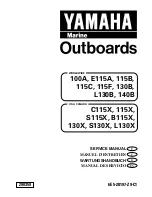
Installing the Motherboard
User’s Manual
2-17
(14). PS/2 Mouse Connector
Attach a PS/2 mouse to this 6-pin Din-connector.
(15). Serial Port COM1 & COM2 Port Connectors
This motherboard provides two COM ports, you can connect an external modem, mouse or other devices
that support this communication protocol to these connectors.
You can decide which external devices you want to connect to COM1 and COM2. Each COM port can
only have one device connected at a time.
(16). Parallel Port Connector
This parallel port is also called an “
LPT
”
port, because it usually connects to the
printer. You can connect other devices that
support this communication protocol, like
an EPP/ECP scanner, etc.
(17). USB Port Connectors
This motherboard provides two USB ports. Attach the USB connector from the individual device to these
connectors.
You can attach USB devices such as a, scanner, digital speakers, monitor, mouse, keyboard, hub, digital
camera, joystick etc. to one of each
USB connector. You must make
sure your operating system supports
this feature and you may need to
install an additional driver for
individual devices. In Please refer to
your device user’s manual for
detailed information.
(18). 10/100 Mb LAN Port Connector
This motherboard provides one built-in 10/100 Mb LAN port, this jack is for connecting the RJ-45 cable
from the local area network hub to your computer. We suggest you use the category 5 UPT (
U
nshielded
T
wisted
P
air) or STP (
S
hielded
T
wisted
P
air) cable to make this connection. The connection length from
the hub to the computer is best to be kept under 100 meter.
The green LED shows the connection situation. If the network active well, this LED will light on. The
yellow LED shows if the data is active or not. If the computer is translating or receiving data from the
network, this LED will flicker.
(19). Line Out, Line In and Mic In Connector
Line Out connector:
You can connect an external stereo speaker signal input plug to this connector, or
you can connect the plug from here to the stereo audio equipment AUX signal input socket. Remember,
the motherboard does not have a built in amplifier to drive the speaker, so you must use a speaker that has
Содержание NV7-133R
Страница 2: ......
Страница 10: ...Chapter 1 NV7 133R 1 6 ...
Страница 58: ...Chapter 3 NV7 133R 3 30 ...
Страница 68: ...5 4 Chapter 5 NV7 133R ...
Страница 72: ...6 4 Chapter 6 NV7 133R ...
Страница 76: ...Appendix A NV7 133R A 4 ...
Страница 96: ...F 4 Appendix F NV7 133R ...
















































